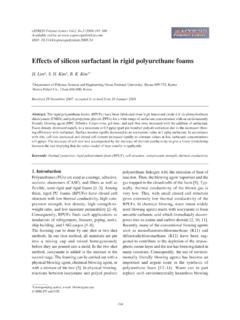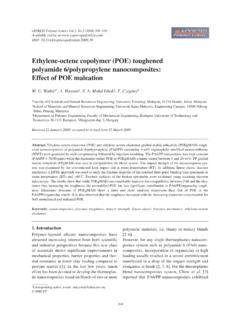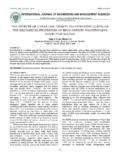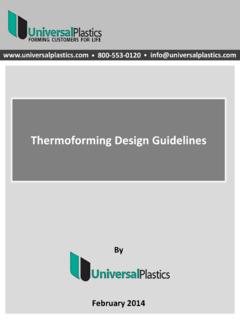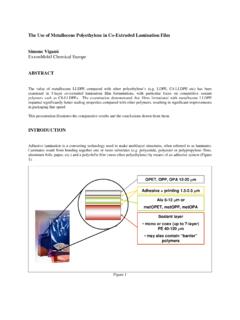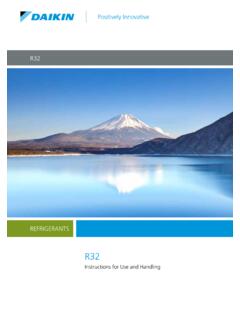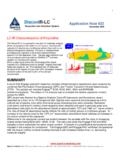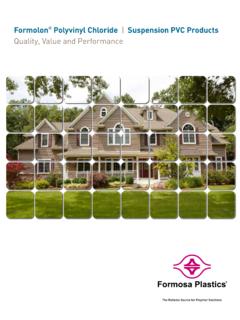Transcription of Comparative study of the morphology and properties of PP ...
1 1. IntroductionThe blending of two or more polymers is a cheaperand more effective alternative, not only for thedevelopment of polymers with new properties , butalso for recycling of greener materials [1 3].Polypropylene/polyethylene (PP/PE) blends areamongst polymer blends that were studied by vari-ous researchers [4 6]. Three different types of PE,namely low-density polyethylene (LDPE), high-density polyethylene (HDPE), and linear low-den-sity polyethylene (LLDPE) were used to modifythe physical and mechanical behaviour of PP byforming physical blends [2].
2 The interest in PP andPE is specifically due to the fact that both thesepolymers are widely used as important engineeringmaterials in the automotive, electrical appliancesand packaging industries due to their excellentproperties such as rigidity and stiffness, oil resist-ance and their thermal stability [7]. Apart fromthese good properties that PP has, its applicationsare often limited due to its low impact strength andYoung s modulus, particularly at low and high tem-perature loading conditions. These PP drawbackscan be considerably improved by blending PP withother polymers [7 9].
3 Blending of PP and different PEs largely dependson the miscibility or immiscibility of the two com-ponents. PP and LDPE or HDPE are generally con-sidered immiscible in the whole composition rangeand shows a remarkable phase separation during729*Corresponding author, e-mail: BME-PTComparative study of the morphology and properties ofPP/LLDPE/wood powder and MAPP/LLDPE/wood powderpolymer blend compositesD. G. Dikobe, A. S. Luyt*Department of Chemistry, University of the Free State (Qwaqwa Campus), Private Bag X13, Phuthaditjhaba, 9866,South AfricaReceived 1 June 2010; accepted in revised form 13 August this study , polypropylene (PP)/linear low-density polyethylene (LLDPE) and maleic anhydride graftedpolypropylene (MAPP)/LLDPE blend systems were comparatively investigated.
4 The blends and composites containedequal amounts of the two polymers, and the compatibility and miscibility between the two polymers were with 10, 20 and 30 wt% wood powder (WP), but still with equal amounts of the two polymers, were preparedand investigated. The morphologies, as well as mechanical and thermal properties , of the blends and the blend compositeswere investigated. The MAPP/LLDPE blend and composites showed better properties than the PP/LLDPE blend and com-posites as a result of the stronger interfacial interaction between MAPP, LLDPE and WP. The SEM and DSC results of thePP/LLDPE/WP blend composites showed that WP located itself more in the LLDPE phase.
5 In the MAPP/LLDPE/WPcomposites the WP was in contact with both polymers, although it had a greater affinity for MAPP. The TGA results showthat the MAPP/LLDPE blend and composites are more thermally stable than the PP/LLDPE blend and :polymer composites, polypropylene, maleic anhydride grafted polypropylene, linear low-density polyethylene,wood powdereXPRESS Polymer Letters , (2010) 729 741 Available online at : [2, 7, 9]. On the other hand,PP and LLDPE are considered to be compatible inthe liquid state. However, PP/LLDPE miscibility isrestricted by the processing conditions, composi-tion and high temperatures.
6 If a blend of PP andLLDPE is cooled from a miscible melt it may sepa-rate into two phases resulting in an immiscibleblend [10].The incorporation of fillers into thermoplastics isanother method widely used to enhance certainproperties. The degree of property enhancementdepends on the filler particle size and shape, thecontent of filler, the surface treatment promotinginteraction between the polymer matrix and fillerand most importantly the filler s origin [11]. Nat-ural fibres are favoured over synthetic fibres due tostrict environmental policies that promote the man-ufacturing of biodegradable materials.
7 One of thedisadvantages of using natural fibres is that they areincompatible with hydrophobic PP (MAPP) has been widely used atlow concentrations as a compatibilizing agent andadhesion promoter for bio-filler filled polypropy-lene composites. The maleic anhydride (MA) func-tional group which grafts onto the PP backboneacts as a chemical link between the hydrophobicmatrix polymer and the hydrophilic surface of natu-ral fillers [12 17].Two ways used to improve polymer properties arepolymer blending and the use of filler to form poly-mer composites. These two methods were exten-sively, but separately used.
8 Studies dealing withpolymer blends reinforced with rigid fillers to givethree-phase polymer composites are still fairly new[18]. In cases where these studies were done, syn-thetic and mineral fibres such as talc, glass fibreand calcium carbonate (CaCO3) were used as fillers[18 21]. Very few studies of ternary systems involv-ing natural fibres as reinforcement were reported[11, 22 25].In this study , PP/LLDPE and MAPP/LLDPE blendsystems, where the two polymers in each systemwere mixed in equal quantities, were comparativelyinvestigated. This work was primarily a study onthe interaction of wood powder (WP) particles withone or more of the phases of different 50/50 w/wpolyolefin blends, and of the influence of the pres-ence of WP particles and the respective interactionson the crystallization and melting behaviour of thedifferent polymers in the blends.
9 Maleic anhydridegrafted polypropylene (MAPP) was introduced tocompare the properties of PP/PE blend compositeswhen one of the polymer phases (PP) is replaced byits functionalized equivalent (MAPP). The mor-phologies, thermal stabilities and mechanical prop-erties of the blends and blend composites were Materials MAPP, supplied by Pluss Polymers Pvt. Ltd.(India), has a density of g cm 3, a meltingpoint of 161 C, a tensile strength of 24 MPa and amelt flow index (MFI) of 55 g/10 min (190 C, kg). PP, supplied by Sasol Polymers (Johan-nesburg, South Africa) has a density of g cm 3,a melting point of 165 C and MFI of 12 g/10 min(230 C, kg).
10 LLDPE, supplied by Sasol Poly-mers (Johannesburg, South Africa) has a density g cm 3, a melting point of 127 C and an MFIof g/10 min (190 C, kg). Pine wood pow-der (WP), or pine saw dust, was obtained fromFBW Taurus (Phuthaditjhaba, South Africa). WPwas supplied as a light orange coloured powderwith a density of g cm 3and was dried at 120 Cfor 48 hours. Particles with sizes 150 m wereobtained by sieving the dried WP using a labora-tory test sieve of 150 m pore Preparation of the blends and compositesThe blends and blend composites were weighedaccording to the required ratios (100/0/0, 0/100/0,50/50/0, 45/45/10, 40/40/20, 35/35/30 w/w PP/LLDPE/WP and MAPP/LLDPE/WP) to make up atotal of 38 g (which is the mass required for thor-oughly mixing the different components in theBrabender Plastograph 50 ml mixer).
